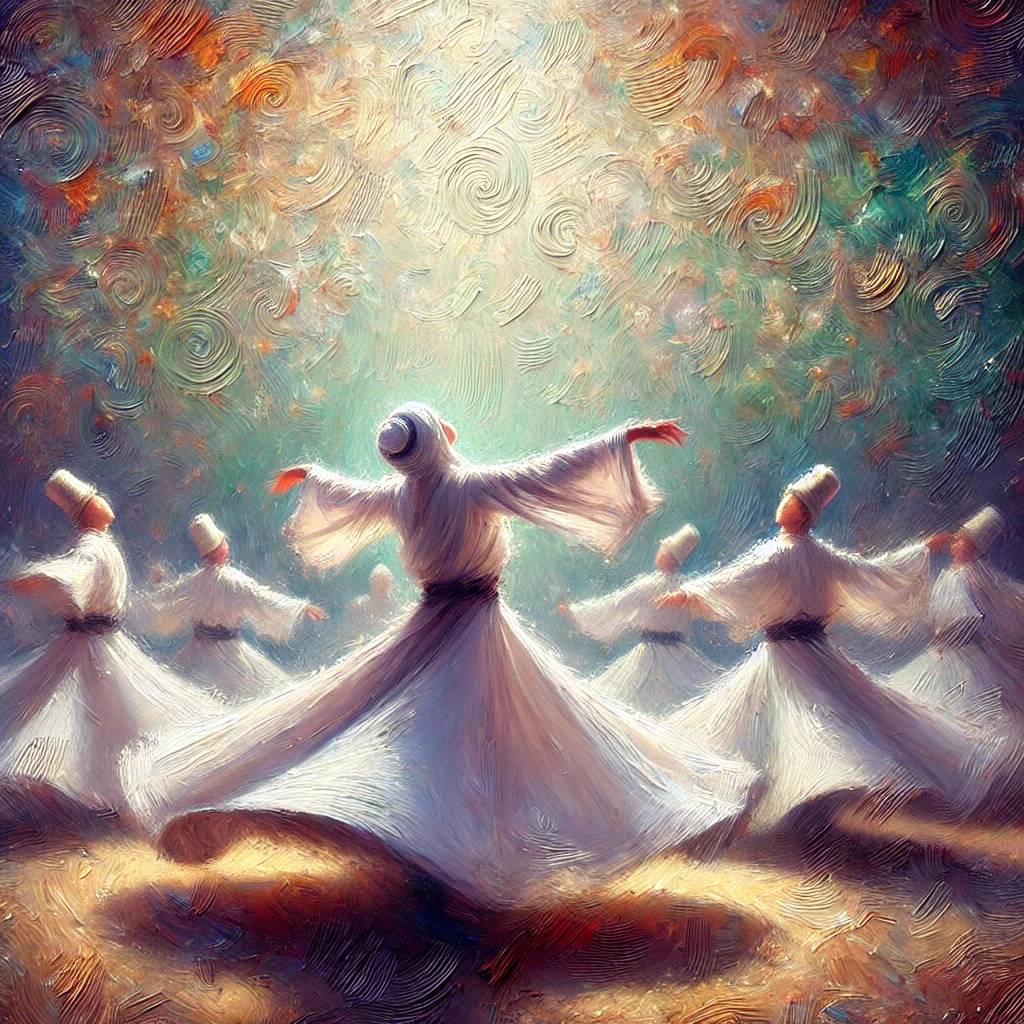
Ancient religious dances
Ancient religious dances from various cultures around the world.
Let us name a few examples:
1. Sufi Whirling (Turkey)
Sufi whirling is a form of physically active meditation performed within the Sema ceremony by the Sufi Dervishes. This dance is part of the spiritual practice of the Mevlevi order and symbolizes the mystical journey of man’s spiritual ascent through mind and love to “Perfect.”
2. Kathakali (India)
Kathakali is a classical Indian dance-drama known for its elaborate costumes and intricate facial expressions. It originated in the temples of Kerala and often depicts stories from Hindu epics like the Mahabharata and Ramayana.
3. Hula (Hawaii)
Hula is a traditional Hawaiian dance accompanied by chant or song. It is performed to honor deities, express stories, and convey the history and traditions of the Hawaiian people.
4. Shamanic Dance (Various Indigenous Cultures)
Shamanic dances are found in many indigenous cultures worldwide. These dances are typically part of rituals performed by shamans to communicate with the spirit world, heal the sick, or ensure success in hunting or harvesting.
5. Gagaku (Japan)
Gagaku is a type of Japanese classical music that includes dance (Bugaku) and is performed at the Imperial court and in some Shinto shrines and Buddhist temples. It includes both native Japanese traditions and influences from Chinese and Korean culture.
6. Dervish Dance (Middle East)
The Dervish dance, associated with the followers of Sufi Islam, involves spinning movements that are meant to induce a trance-like state, helping the dancer to connect with the divine.
7. Balinese Dance (Indonesia)
Balinese dance is an ancient dance tradition that is part of the religious and artistic expression of the Balinese people. These dances are often performed during temple ceremonies and festivals.
8. Noh (Japan)
Noh is a traditional form of Japanese theater that combines music, dance, and drama. It often features themes of gods, warriors, and spirits, and is performed as part of religious and cultural ceremonies.
These dances are not just artistic performances but are deeply rooted in the spiritual and cultural practices of their respective communities.
Online ressources
There are various online resources where you can learn more about these ancient religious dances. Here are some suggestions for each dance:
Sufi Whirling
- Websites:
- The Mevlevi Order – Information about the Mevlevi Sufi order and its practices.
- Whirling Dervishes – Wikipedia page with detailed information.
- Videos:
- YouTube: Sufi Whirling – A collection of videos demonstrating the dance.
Kathakali
- Websites:
- Kathakali.info – Comprehensive resource on Kathakali dance.
- Kerala Tourism: Kathakali – Information from Kerala Tourism.
- Videos:
- YouTube: Kathakali Performances – Videos of Kathakali performances.
Hula
- Websites:
- Hawaiian Hula Dance – Resources and information on Hula.
- Hula Preservation Society – Organization dedicated to preserving Hula.
- Videos:
- YouTube: Hula Dance – Hula dance performances.
Shamanic Dance
- Websites:
- Shamanism Today – Information on shamanic practices and dances.
- Shaman Portal – Resource for shamanic traditions.
- Videos:
- YouTube: Shamanic Dance – Various shamanic dance rituals.
Gagaku (Bugaku)
- Websites:
- Japan Arts Council: Gagaku – Information on Gagaku and Bugaku.
- Gagaku Society – Dedicated to the preservation of Gagaku.
- Videos:
- YouTube: Gagaku – Performances of Gagaku music and dance.
Dervish Dance
- Websites:
- Sufi Dance – Information on Sufi dance practices.
- Whirling.org – Resources on the Dervish dance.
- Videos:
- YouTube: Dervish Dance – Various Dervish dance videos.
Balinese Dance
- Websites:
- Bali Dance Academy – Information on Balinese dance forms.
- Indonesian Performing Arts – Resources on traditional Indonesian dances.
- Videos:
- YouTube: Balinese Dance – Performances of Balinese dance.
Noh
- Websites:
- Noh.com – Comprehensive resource on Noh theater.
- Japan Arts Council: Noh – Information on Noh theater.
- Videos:
- YouTube: Noh Theater – Videos of Noh performances.
These resources should provide a solid starting point for exploring and learning about these fascinating and culturally rich dances.
Multilingual Folk Song Explorer GPT
Engaging and comprehensive folk song guide with interactive and multimedia features.
Multilingual Folk Song Explorer
Make your own folk website online!
Turn your passion into profit today and start your own online journey. Learn how to create and grow your website withna fabulous community and join for free!

